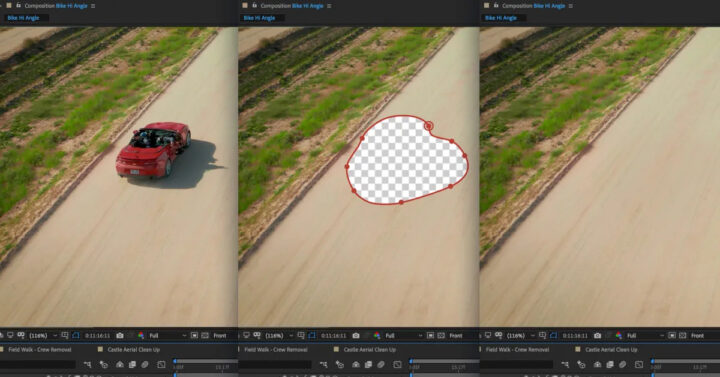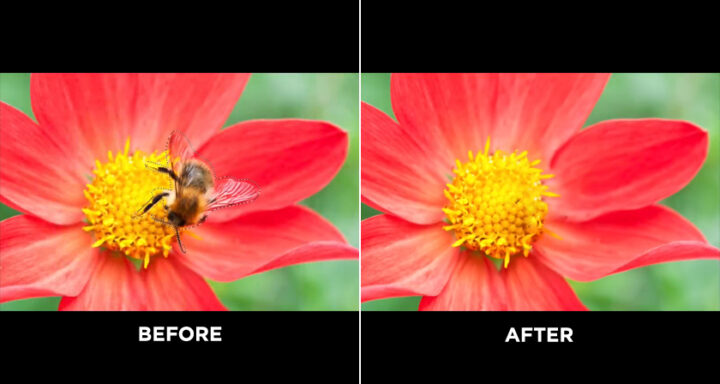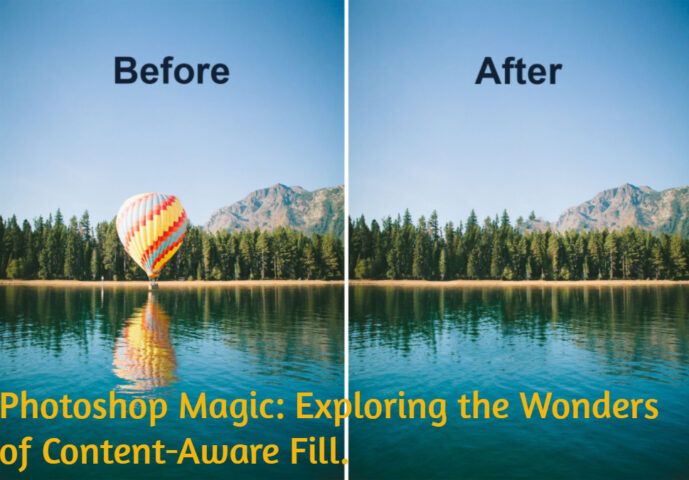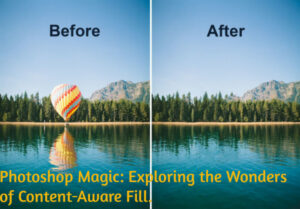In the dynamic realm of photo editing dominated by Photoshop, content-aware fill stands out as a game-changing feature. Renowned as the industry standard, Photoshop provides a plethora of tools. Content-aware fill harnesses the power of artificial intelligence to redefine the editing landscape. This tool seamlessly eradicates undesired elements or objects from photographs. Employing intelligent analysis of surrounding pixels and patterns to generate a natural-looking fill that seamlessly integrates with the original image. In this blog post, we’ll unravel the capabilities, applications, and practical steps for maximizing the potential of content-aware fill. Showcasing its transformative impact on photo editing.
Content-aware fill excels at effortlessly removing unwanted elements. Such as power lines or blemishes, and adeptly filling in missing areas, revitalizing the composition with imperceptible alterations. Beyond mere retouching, this tool enhances overall image quality, contributing to a polished and professional aesthetic.
What you will see here?
What is Content-Aware Fill in Photoshop?

Content-Aware Fill, a revolutionary feature in
The magic lies in its contextual understanding of surrounding image data, allowing it to generate realistic content that seamlessly integrates. However, success depends on image complexity and the area’s size, occasionally requiring manual adjustments. Content-Aware Fill primarily focuses on removing unwanted elements and filling gaps, simplifying image restoration without complex editing. Ideal for both seasoned photographers and casual users, it streamlines the process, ensuring professional-looking results with minimal effort. The next time a distracting element or missing piece hinders your photo, harness the transformative power of Content-Aware Fill for a significantly improved outcome.
How to use Content-Aware Fill?

Content-Aware Fill in Photoshop is a potent tool for effortlessly eliminating undesired elements from your images. Begin by duplicating the background layer to create a safeguard against errors. Use the appropriate selection tool (Marquee, Lasso, or Object Selection) to choose the target object meticulously. Subsequently, navigate to Edit > Fill, opt for “Content-Aware” in the “Fill” dialog, and fine-tune sampling preferences if necessary. Execute the fill, allowing Photoshop to seamlessly replace the selected area with surrounding pixels.
After pressing Ctrl + D to deselect, scrutinize the outcome closely. If imperfections persist, employ tools like the Spot Healing Brush or Patch tool for manual refinement. Duplicate the background layer again before tackling additional objects. For intricate scenarios, consider the “Content-Aware Move” tool to relocate objects seamlessly. Experiment with diverse “Sampling” options and leverage the “Refine Edge” tool post-fill to enhance blending. Through consistent practice, master the art of using Content-Aware Fill to enhance your photos by effortlessly eradicating unwanted elements, resulting in a polished and refined appearance.
What are the different options?

Content-Aware Fill stands out as a robust image editing tool, offering users the capability to effortlessly eliminate unwanted elements from their photos while seamlessly blending the background. The tool’s versatility is showcased through various customization options. Users can precisely define the sampling area with choices like Auto for intelligent analysis or Rectangular and Custom for more manual control. Adaptation options, including None, Normal, and High, provide control over how sampled pixels integrate with the surroundings. Opacity adjustments, color selection, and the Fade feature contribute to the fine-tuning of the filled area.
The Match Source option accommodates scenarios where the object being removed differs in color or texture from the surroundings. Beyond these, additional features like edge refinement, dust and scratch removal, and the ability to fill larger areas enhance the tool’s utility. Ultimately, Content-Aware Fill proves itself as a versatile and indispensable asset in achieving diverse editing goals, allowing users to experiment and tailor settings to their specific creative needs.
What are some tips for getting good results with Content-Aware Fill?

Mastering the capabilities of Content-Aware Fill in Photoshop is not merely about clicking and selecting. It demands a nuanced approach for impeccable outcomes. To harness the full potential of this powerful tool, start with precision in the selection. Use tools like the Pen Tool and Quick Selection Tool. And refine with the Refine Edge brush to ensure a clean and artifact-free result. The dedicated Content-Aware Fill workspace offers a magnified view and additional tools for enhanced refinement. Allowing you to sample specific areas, and adjust Fill Modes based on image content. And fine-tune rotation and scaling for a seamless blend.
Experimentation is key, and trying out different Fill Modes—such as “Adaptive” for complex textures or “Color Aware” for preserving color—adds versatility to your editing arsenal. Layer masks become invaluable for further refinement, providing precise control over the filled area. The Patch Tool can step in for complex edits, seamlessly copying and pasting image portions to correct imperfections.
Remember, mastering Content-Aware Fill is an evolving skill that benefits from consistent practice. Begin with simpler edits and progressively tackle more complex tasks. Seek inspiration and tutorials online, tapping into the wealth of knowledge and experiences shared by seasoned users. Through precision, control, creativity, and regular practice, you’ll unlock the full potential of Content-Aware Fill, creating impactful and flawlessly blended edits.
What are the limitations of Content-Aware Fill?

Content-Aware Fill (CAF) in image editing software is a potent solution for removing unwanted elements, but its effectiveness encounters limitations in various scenarios. Particularly challenged in complex scenes with intricate backgrounds or multiple objects, CAF struggles to seamlessly blend filled areas, resulting in noticeable seams or artifacts. Its dependency on existing details poses challenges when faced with regions lacking ample detail or variation, as seen in solid-colored backgrounds or areas with repetitive textures. Repeating patterns can lead to unintended replication, causing distracting and unnatural effects, especially with intricate designs.
The unpredictable nature of CAF’s algorithmic approach requires multiple attempts to achieve the desired outcome, adding a layer of complexity and potential frustration. While faster than manual retouching, CAF remains time-consuming, demanding user input and adjustments, especially for larger edits or intricate images. Moreover, its inability to comprehend the context of an image poses risks, as it may inadvertently remove crucial information or create nonsensical compositions. The limited creative control, compared to manual retouching, and potential legal issues surrounding copyrighted material further highlight the tool’s constraints. In navigating these limitations, users can harness CAF effectively by understanding its boundaries and applying it judiciously for realistic and professional results.
What are some alternatives to Content-Aware Fill?
While Content-Aware Fill remains a favored tool in image editing, many alternatives with distinct strengths and weaknesses have emerged to cater to diverse user preferences. Among the free and online options, Pincel stands out for its user-friendly interface and advanced AI technology, seamlessly filling unwanted elements without the need for software downloads. Inpaint provides a comparable online alternative, emphasizing efficient content filling and object removal. Fotor, as an online editor, integrates a Content-Aware Fill tool into its feature-rich suite, offering basic editing capabilities without requiring additional software installation.
For standalone and paid software solutions, GIMP’s Resynthesizer provides a powerful tool similar to Content-Aware Fill, though it demands more user input and may be less intuitive. AKVIS Chameleon, a dedicated content-aware editing software, offers various fill modes and advanced control. SuperCopy specializes in object removal and background replacement, employing AI technology for precise and seamless results.
In addition to these, alternative techniques like the Clone Stamp Tool and Healing Brush Tool cater to manual copying, pasting, and seamless blending of image content. Moreover, Photoshop’s Content-Aware Move Tool facilitates object repositioning with automatic filling of the vacated area. The optimal choice depends on individual needs, budget considerations, and technical proficiency, urging users to experiment with different tools to align with their specific image editing goals and workflow preferences.
How is Content-Aware Fill different from Content-Aware Move?
Content-Aware Fill and Content-Aware Move, both employing sophisticated algorithms for seamless image manipulation, diverge conceptually in their applications. Content-Aware Fill primarily addresses the removal of undesired elements. Acting akin to a digital painter meticulously replenishing voids with brushstrokes mirroring the adjacent texture and color. Users select the target area for removal. The tool analyzes surrounding content to generate a replacement seamlessly blending into the image. Ideal for eliminating blemishes, unwanted objects, or expanding image boundaries.
In contrast, Content-Aware Move focuses on repositioning existing elements within an image. Resembling a virtual surgeon delicately relocating an organ within a body to ensure natural integration. Users select the object to be moved, and the tool analyzes surrounding content to seamlessly fill the void left behind. This capability facilitates creative image manipulations such as object rearrangement, the addition of missing elements, or even facial swaps.
To illustrate the distinction, consider renovating a room: Content-Aware Fill repairs damaged wallpaper by meticulously patching it with a matching pattern. While Content-Aware Move shifts a bookshelf to a different wall, seamlessly filling the original space with elements from the surroundings. Both tools offer remarkable capabilities, and comprehending their conceptual disparities aids in selecting the appropriate tool for specific image editing requirements.
What are the ethical considerations of using Content-Aware Fill?
Content-Aware Fill (CAF) in image editing, while a potent tool for seamlessly altering images. Brings forth a host of ethical concerns. One major issue is the potential for misrepresentation, as CAF can be wielded to create misleading images. Altering the context of historical or journalistic photographs and impacting public perception. Moreover, the tool’s capacity to subtly manipulate a person’s appearance raises concerns about identity manipulation. Fostering the spread of misinformation and negatively affecting individuals.
Privacy erosion is another ethical quandary, as CAF can strip images of identifying features, hindering accountability and impeding investigative journalism. In creative works, questions about artistic integrity arise, with over-reliance on CAF potentially diluting an artist’s vision. Transparent disclosure becomes crucial, especially in commercial contexts, where consumers have the right to know if images are manipulated.
Algorithmic biases in CAF, stemming from training data, may perpetuate inaccuracies or discriminatory representations. The tool’s pervasive use could have unforeseen consequences, challenging our ability to distinguish reality from fiction and undermining trust in visual media.
In summary, while Content-Aware Fill provides indispensable image editing capabilities, its ethical implications demand meticulous consideration. Responsible use necessitates transparency, respect for individual rights, and an understanding of its potential to distort reality and diminish trust in the visual representation of our world.
Conclusion
In conclusion, content-aware fill stands as a revolutionary force in the ever-evolving realm of photo editing, and Photoshop’s implementation of this feature sets an industry standard. This tool transcends traditional editing boundaries. Seamlessly eliminating unwanted elements while skillfully reconstructing missing areas with a natural finesse that enhances overall image quality. Its transformative impact extends beyond mere retouching. Contributing to a polished and professional aesthetic that caters to the needs of both seasoned professionals and enthusiastic beginners. The efficiency of content-aware fill becomes evident in its ability to save time and effort, Compared to conventional editing methods, unlocking new realms of creativity for photographers and graphic designers. As an invaluable ally, content-aware fill empowers users to elevate their editing skills. Facilitating the creation of visually striking and exceptional compositions.














